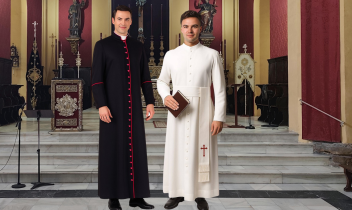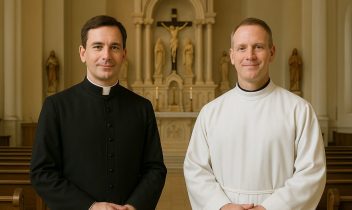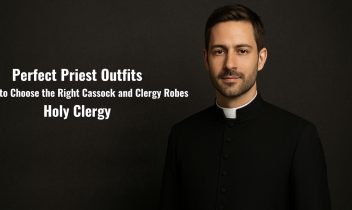No products in the cart.
Return To Shop
Catholic Church Priest Clothing are the Vestments of Faith
In the realm where tradition meets trend, the Catholic Church Priest Clothing worn by Catholic priests stand as timeless symbols of faith and sartorial elegance. Join us on a journey through the rich history, emerging trends, and personal testimonies that weave together to shape the distinctive world of Catholic priest clothes.
The Tapestry of Tradition
To understand the evolution of Clergy Cassock, we must embark on a journey through history. From the humble beginnings of the cassock and alb to the intricately embroidered chasubles of the Renaissance, each garment tells a story of devotion and adaptation. The thread of tradition runs deep, connecting contemporary clergy to centuries of religious practices.
Traditional Trends in Catholic Priest Clothes
While the essence of Catholic priest clothes remains rooted in tradition, modern trends have seen a resurgence of appreciation for classical vestments. Elaborate embroidery, rich fabrics, and a return to more traditional styles reflect a desire to reconnect with the sacred rituals that have defined the Catholic Church for centuries.

Ecclesiastical Elegance and Exploring Contemporary Trends
In recent years, a subtle shift in Catholic priest clothes trends has emerged. Designers are incorporating modern aesthetics without compromising the sanctity of the garments. Slimmer silhouettes, contemporary fabrics, and minimalist designs are gaining popularity, creating a delicate balance between the timeless and the timely.
The Personal Stories Behind the Clothes
Beyond the seams and stitches lie the personal testimonies of the clergy who don these sacred garments. Each priest’s choice of attire is a testament to their spiritual journey, a visual expression of their commitment to their vocation. Some find solace in the continuity of tradition, while others embrace the evolving landscape of liturgical fashion.
Colors of Faith in Catholic Priest Clothes
The colors adorning Catholic priest clothes hold profound significance. From the purity of white to the penitential tones of purple, each hue symbolizes different aspects of the liturgical calendar. Exploring the symbolism behind these colors unveils a narrative that enhances the spiritual depth of the Priest’s Attire.
A Guide to Catholic Priest Clothes | Catholic Church Priest Clothing
For those seeking to understand the art of adorning Catholic priest clothes, a guide to the selection and significance of each garment is essential. From the cassock as a symbol of humility to the chasuble representing the yoke of Christ, we delve into the craftsmanship and meaning behind every element of this divine ensemble.
Global Influences on Catholic Priest Clothes

The Catholic Church’s global reach brings diverse influences to Priest’s Attire. Cultural nuances shape the design and embellishments of vestments, creating a beautiful mosaic of diversity within the unity of faith. Exploring these global influences enriches our understanding of the universal language spoken through Catholic priest clothes.
In the intricate weave of history, trends, and personal testimonies, Catholic priest clothes emerge as more than mere garments—they are sacred vessels that carry the weight of tradition, the pulse of contemporary expression, and the testimony of unwavering faith. As we navigate the evolving landscape of liturgical fashion, the vestments worn by Catholic priests continue to be both a visual spectacle and a profound statement of devotion.
RELATED SEARCHES
Why Priests Should Wear Cassocks?
Priests should wear cassocks for a multitude of reasons. Beyond its historical significance and adherence to tradition, the cassock serves as a visual representation of the priest’s commitment to humility, simplicity, and dedication to their vocation. This distinctive garment fosters a sense of reverence and embodies the priestly role, creating a powerful symbol that resonates with both the clergy and the community.
Why do priests wear a cassock?
Priests wear cassocks as a symbol of their commitment to religious service. The cassock embodies humility, simplicity, and adherence to tradition. Serving as a distinctive and recognizable garment, it fosters a sense of reverence and underscores the priest’s dedication to their vocation. This traditional attire holds both historical significance and conveys the priest’s role within the sacred context of their ministry.
What is the function of cassock?
The cassock serves a dual purpose for priests. Functionally, it is a traditional, ankle-length robe designed for ease of movement during liturgical rituals. Symbolically, the cassock represents the priest’s commitment to humility, simplicity, and religious service. It acts as a visual identifier of the priestly role and fosters a sense of reverence within the community.
Why do priests wear what they wear?
Priests wear specific attire, known as liturgical vestments, to symbolize their sacred role and convey spiritual significance during religious ceremonies. Each garment, from the cassock to the chasuble, holds unique symbolism, reflecting humility, purity, and adherence to tradition. This distinctive attire serves as a visual language, communicating the priest’s commitment to their vocation and enhancing the overall reverence of worship.
Why do seminarians wear cassocks?
Seminarians wear cassocks as a visible expression of their commitment to religious formation and preparation for priesthood. The cassock symbolizes their dedication to a life of humility, simplicity, and spiritual service. Additionally, wearing this distinctive garment fosters a sense of identity and unity within the seminary community, marking a significant step in their journey toward priesthood.
Welcome to the Clergy Wear Shop, where sacred attire meets style. Discover a curated collection of liturgical vestments and accessories for clergy members. From traditional robes to modern interpretations, we offer a diverse range that combines reverence with contemporary elegance. Explore our selection and embody the essence of sacred service with our thoughtfully crafted clergy wear.








Add comment
You must be logged in to post a comment.